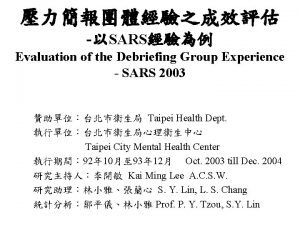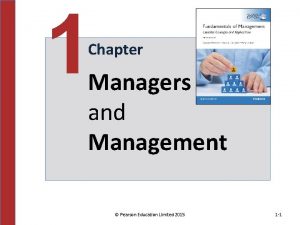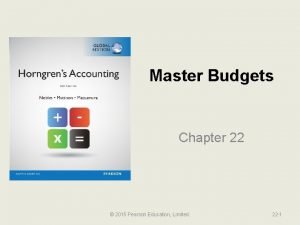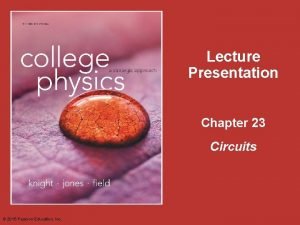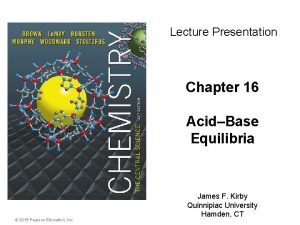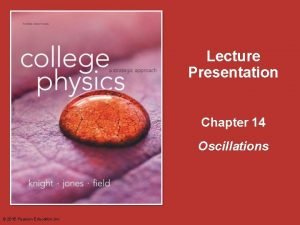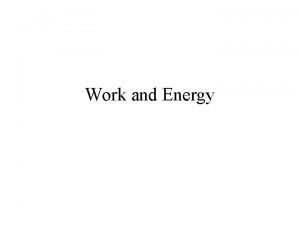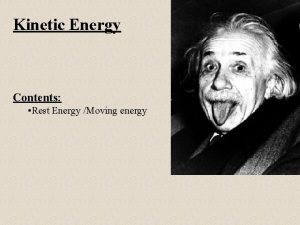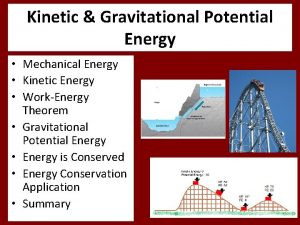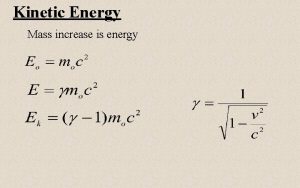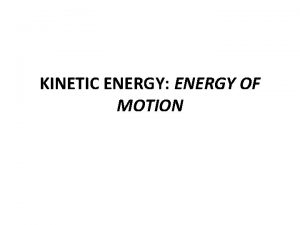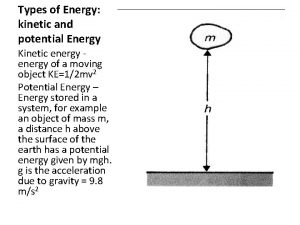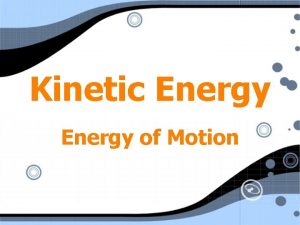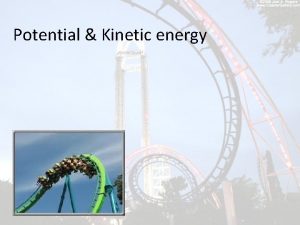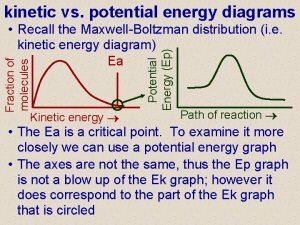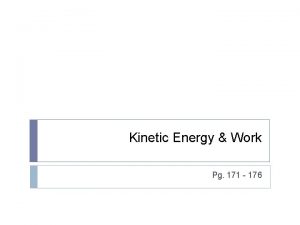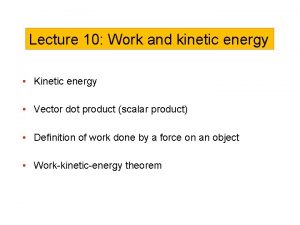Section 10 3 Kinetic Energy cont 2015 Pearson



































- Slides: 35

Section 10. 3 Kinetic Energy (cont. ) © 2015 Pearson Education, Inc.

Recall • Work W done by a force of magnitude F over a straight-line displacement d, where the angle between the force and the displacement is θ. W = Fd cos θ • Total Kinetic Energy Ktot of an object with mass m, moment of inertia I, speed v, and angular speed ω. Ktot = (½)m v 2 + (½) I ω2 • Work-energy Theorem ΔKtot = Wnet © 2015 Pearson Education, Inc. Slide 10 -2

Quick. Check 10. 10 A light plastic cart and a heavy steel cart are both pushed with the same force for a distance of 1. 0 m, starting from rest. After the force is removed, the kinetic energy of the light plastic cart is ____ that of the heavy steel cart. A. B. C. D. greater than equal to less than Can’t say. It depends on how big the force is. © 2015 Pearson Education, Inc. Slide 10 -3

Quick. Check 10. 10 A light plastic cart and a heavy steel cart are both pushed with the same force for a distance of 1. 0 m, starting from rest. After the force is removed, the kinetic energy of the light plastic cart is ____ that of the heavy steel cart. A. B. C. D. greater than Same force, same distance same work done equal to Same work change of kinetic energy less than Can’t say. It depends on how big the force is. © 2015 Pearson Education, Inc. Slide 10 -4

Quick. Check 10. 11 Each of the boxes shown is pulled for 10 m across a level, frictionless floor by the force given. Which box experiences the greatest change in its kinetic energy? © 2015 Pearson Education, Inc. Slide 10 -5

Quick. Check 10. 11 Each of the boxes shown is pulled for 10 m across a level, frictionless floor by the force given. Which box experiences the greatest change in its kinetic energy? D Work-energy equation: ∆K = W = Fd. All have same d, so largest work (and hence largest ∆K) corresponds to largest force. © 2015 Pearson Education, Inc. Slide 10 -6

Quick. Check 10. 12 Each of the 1. 0 kg boxes starts at rest and is then is pulled for 2. 0 m across a level, frictionless floor by a rope with the noted force at the noted angle. Which box has the highest final speed? © 2015 Pearson Education, Inc. Slide 10 -7

Quick. Check 10. 12 Each of the 1. 0 kg boxes starts at rest and is then is pulled for 2. 0 m across a level, frictionless floor by a rope with the noted force at the noted angle. Which box has the highest final speed? B © 2015 Pearson Education, Inc. Slide 10 -8

Section 10. 4 Potential Energy © 2015 Pearson Education, Inc.

Potential Energy • Potential energy is stored energy that can be readily converted to other forms of energy, such as kinetic or thermal energy. • Forces that can store useful energy are conservative forces: • Gravity • Elastic forces • Forces such as friction that cannot store useful energy are non-conservative forces. • Only conservative forces have associated potential energy © 2015 Pearson Education, Inc. Slide 10 -10

Gravitational Potential Energy The change in gravitational potential energy is proportional to the change in its height. Where is the gravitational potential energy? It is really stored in the gravitational field, but for this course we will just consider it to be part of the object-earth system. © 2015 Pearson Education, Inc. Slide 10 -11

Gravitational Potential Energy • We can choose the reference level where gravitational potential energy Ug = 0 since only changes in Ug matter. • Because gravity is a conservative force, gravitational potential energy depends only on the height of an object and not on the path the object took to get to that height. © 2015 Pearson Education, Inc. Slide 10 -12

Example A cannon tilted upwards at an angle of 32º fires a cannonball at speed of 80. m/s from atop a 15 m fortress wall. What is the speed of the cannonball when it strikes the ground (ignoring air resistance)? © 2015 Pearson Education, Inc. Slide 10 -13

Quick. Check 10. 13 Rank in order, from largest to smallest, the gravitational potential energies of the balls, where the velocity is as shown. A. B. C. D. 1>2=4>3 1>2>3>4 3>2>4>1 3>2=4>1 © 2015 Pearson Education, Inc. Slide 10 -14

Quick. Check 10. 13 Rank in order, from largest to smallest, the gravitational potential energies of the balls, where the velocity is as shown. A. B. C. D. 1>2=4>3 1>2>3>4 3>2>4>1 3>2=4>1 © 2015 Pearson Education, Inc. Slide 10 -15

Quick. Check 10. 14 Starting from rest, a marble first rolls down a steeper hill, then down a less steep hill of the same height. For which is it going faster at the bottom (ignore rolling friction)? A. B. C. D. Faster at the bottom of the steeper hill. Faster at the bottom of the less steep hill. Same speed at the bottom of both hills. Can’t say without knowing the mass of the marble. © 2015 Pearson Education, Inc. Slide 10 -16

Quick. Check 10. 14 Starting from rest, a marble first rolls down a steeper hill, then down a less steep hill of the same height. For which is it going faster at the bottom (ignore rolling friction)? A. B. C. D. Faster at the bottom of the steeper hill. Faster at the bottom of the less steep hill. Same speed at the bottom of both hills. Can’t say without knowing the mass of the marble. © 2015 Pearson Education, Inc. Slide 10 -17

Quick. Check 10. 15 A small child slides down the four frictionless slides A–D. Rank in order, from largest to smallest, her speeds at the bottom. A. B. C. D. v. D > v. A > v. B > v. C v. D > v. A = v. B > v. C > v. A > v. B > v. D v. A = v. B = v. C = v. D © 2015 Pearson Education, Inc. Slide 10 -18

Quick. Check 10. 15 A small child slides down the four frictionless slides A–D. Rank in order, from largest to smallest, her speeds at the bottom. A. B. C. D. v. D > v. A > v. B > v. C v. D > v. A = v. B > v. C > v. A > v. B > v. D v. A = v. B = v. C = v. D © 2015 Pearson Education, Inc. Slide 10 -19

Elastic Potential Energy • Elastic (or spring) potential energy is stored when a force compresses a spring. • Hooke’s law describes the force required to compress a spring. © 2015 Pearson Education, Inc. Slide 10 -20

Elastic Potential Energy The elastic potential energy stored in a spring is determined by the average force required to compress the spring from its equilibrium length. © 2015 Pearson Education, Inc. Slide 10 -21

Quick. Check 10. 16 Three balls are thrown from a cliff with the same speed but at different angles. Which ball has the greatest speed just before it hits the ground? A. B. C. D. Ball A. Ball B. Ball C. All balls have the same speed. © 2015 Pearson Education, Inc. Slide 10 -22

Quick. Check 10. 16 Three balls are thrown from a cliff with the same speed but at different angles. Which ball has the greatest speed just before it hits the ground? A. B. C. D. Ball A. Ball B. Ball C. All balls have the same speed. © 2015 Pearson Education, Inc. Slide 10 -23

Quick. Check 10. 17 A hockey puck sliding on smooth ice at 4 m/s comes to a 1 -m-high hill. Will it make it to the top of the hill? A. B. C. D. Yes. No. Can’t answer without knowing the mass of the puck. Can’t say without knowing the angle of the hill. © 2015 Pearson Education, Inc. Slide 10 -24

Quick. Check 10. 17 A hockey puck sliding on smooth ice at 4 m/s comes to a 1 -m-high hill. Will it make it to the top of the hill? A. B. C. D. Yes. No. Can’t answer without knowing the mass of the puck. Can’t say without knowing the angle of the hill. © 2015 Pearson Education, Inc. Slide 10 -25

Example 10. 8 Pulling back on a bow An archer pulls back the string on her bow to a distance of 70. cm from its equilibrium position. To hold the string at this position takes a force of 140 N. How much elastic potential energy is stored in the bow? A bow is an elastic material, so we will model it as obeying Hooke’s law, Fs = kx, where x is the distance the string is pulled back. We can use the force required to hold the string, and the distance it is pulled back, to find the bow’s spring constant k. Then we can use Equation 10. 15 to find the elastic potential energy. PREPARE © 2015 Pearson Education, Inc. Slide 10 -26

Example 10. 8 Pulling back on a bow (cont. ) SOLVE From Hooke’s law, the spring constant is Then the elastic potential energy of the flexed bow is When the arrow is released, this elastic potential energy will be transformed into the kinetic energy of the arrow. According to Table 10. 1, the kinetic energy of a 100 mph fastball is about 150 J, so 49 J of kinetic energy for a fast-moving arrow seems reasonable. ASSESS © 2015 Pearson Education, Inc. Slide 10 -27

Section 10. 5 Thermal Energy © 2015 Pearson Education, Inc.

Thermal Energy Thermal energy is the sum of the kinetic energy of atoms and molecules in a substance and the elastic potential energy stored in the molecular bonds between atoms. © 2015 Pearson Education, Inc. Slide 10 -29

Creating Thermal Energy Friction on a moving object does work. That work creates thermal energy. © 2015 Pearson Education, Inc. Slide 10 -30

Example 10. 9 Creating thermal energy by rubbing A 0. 30 kg block of wood is rubbed back and forth against a wood table 30 times in each direction. The block is moved 8. 0 cm during each stroke and pressed against the table with a force of 22 N. How much thermal energy is created in this process? © 2015 Pearson Education, Inc. Slide 10 -31

Example 10. 9 Creating thermal energy by rubbing A 0. 30 kg block of wood is rubbed back and forth against a wood table 30 times in each direction. The block is moved 8. 0 cm during each stroke and pressed against the table with a force of 22 N. How much thermal energy is created in this process? The hand holding the block does work to push the block back and forth. Work transfers energy into the block table system, where it appears as thermal energy according to Equation 10. 16. The force of friction can be found from the model of kinetic friction introduced in Chapter 5, fk = kn; from Table 5. 2 the coefficient of kinetic friction for wood sliding on wood is k = 0. 20. PREPARE © 2015 Pearson Education, Inc. Slide 10 -32

Example 10. 9 Creating thermal energy by rubbing (cont. ) To find the normal force n acting on the block, we draw the free-body diagram of the figure, which shows only the vertical forces acting on the block. © 2015 Pearson Education, Inc. Slide 10 -33

Example 10. 9 Creating thermal energy by rubbing (cont. ) From Equation 10. 16 we have ΔEth = fk Δx, where fk = kn. The block is not accelerating in the y-direction, so from the free-body diagram Newton’s second law gives SOLVE Fy = n w F = may = 0 or n = w + F = mg + F = (0. 30 kg)(9. 8 m/s 2) + 22 N = 24. 9 N The friction force is then fk = kn = (0. 20)(24. 9 N) = 4. 98 N. The total displacement of the block is 2 30 8. 0 cm = 4. 8 m. Thus thermal energy created is ΔEth = fk Δx = (4. 98 N)(4. 8 m) = 24 J ASSESS This modest amount of thermal energy seems reasonable for a person to create by rubbing. © 2015 Pearson Education, Inc. Slide 10 -34

Try It Yourself: Agitating Atoms Vigorously rub a somewhat soft object such as a blackboard eraser on your desktop for about 10 seconds. If you then pass your fingers over the spot where you rubbed, you’ll feel a distinct warm area. Congratulations: You’ve just set some 100, 000, 000, 000 atoms into motion! © 2015 Pearson Education, Inc. Slide 10 -35
 Debriefing report
Debriefing report Cont or cont'd
Cont or cont'd Site:slidetodoc.com
Site:slidetodoc.com Gravitational kinetic energy equation
Gravitational kinetic energy equation Gravitational potential energy vs kinetic energy
Gravitational potential energy vs kinetic energy Mass and thermal energy
Mass and thermal energy The law of conservation of energy states that
The law of conservation of energy states that Examples of potential energy to kinetic energy
Examples of potential energy to kinetic energy The change in mechanical energy
The change in mechanical energy Potential energy
Potential energy Potential energy units
Potential energy units 2015 pearson education inc
2015 pearson education inc 2015 pearson education inc
2015 pearson education inc Pearson education limited 2015
Pearson education limited 2015 Pearson education limited 2015
Pearson education limited 2015 2015 pearson education inc
2015 pearson education inc 2015 pearson education inc
2015 pearson education inc Pearson education limited 2015
Pearson education limited 2015 Pearson education limited 2008
Pearson education limited 2008 Pearson education limited 2015
Pearson education limited 2015 Pearson education limited 2015
Pearson education limited 2015 2015 pearson education inc
2015 pearson education inc Pearson education limited 2015
Pearson education limited 2015 18 / 22
18 / 22 2015 pearson education inc
2015 pearson education inc 2015 pearson education inc
2015 pearson education inc 2015 pearson education inc
2015 pearson education inc Pearson education limited 2015
Pearson education limited 2015 Pearson education limited 2015
Pearson education limited 2015 Pearson 2015
Pearson 2015 Pearson 2015
Pearson 2015 Pearson education
Pearson education 2015 pearson education inc
2015 pearson education inc 2015 pearson education inc
2015 pearson education inc Pearson education 2011
Pearson education 2011 2011 pearson education inc
2011 pearson education inc
